If you have ever experienced randomly finding a beautiful stone laying on the ground, you may be able to understand the allure that entices rockhounds to pursue their endless quest. The determined search often ends with a disappointing and lackluster collection of dull stones gathered as an insurance policy against coming out empty-handed.
 Though some might consider these dull, any wave-washed rock has a certain appeal.
Though some might consider these dull, any wave-washed rock has a certain appeal.
On occasion, the odds are reversed. A glimmering reflection might catch the eye of a meditative pacer as lapping waves on a rocky beach set time. Or maybe a walk down the creek in a local park reveals a unique geologic treat hiding amongst otherwise nondescript specimens. These chance occurrences are enough to fuel the continued efforts of a dedicated 'hounder', as the only point of certainty is this: You will never find them unless you look.

While this principle applies broadly, in this instance we are revisiting a special type of gemstone that I have discussed previously: Lake Superior Agates. In this article we learned how and where they form, admired their stunning beauty, and established a rough idea of their spatial distribution based on the extents of the last glaciation(s). In this article, we will examine how spatial data can be used to identify the best areas to hunt for these incredible stones!
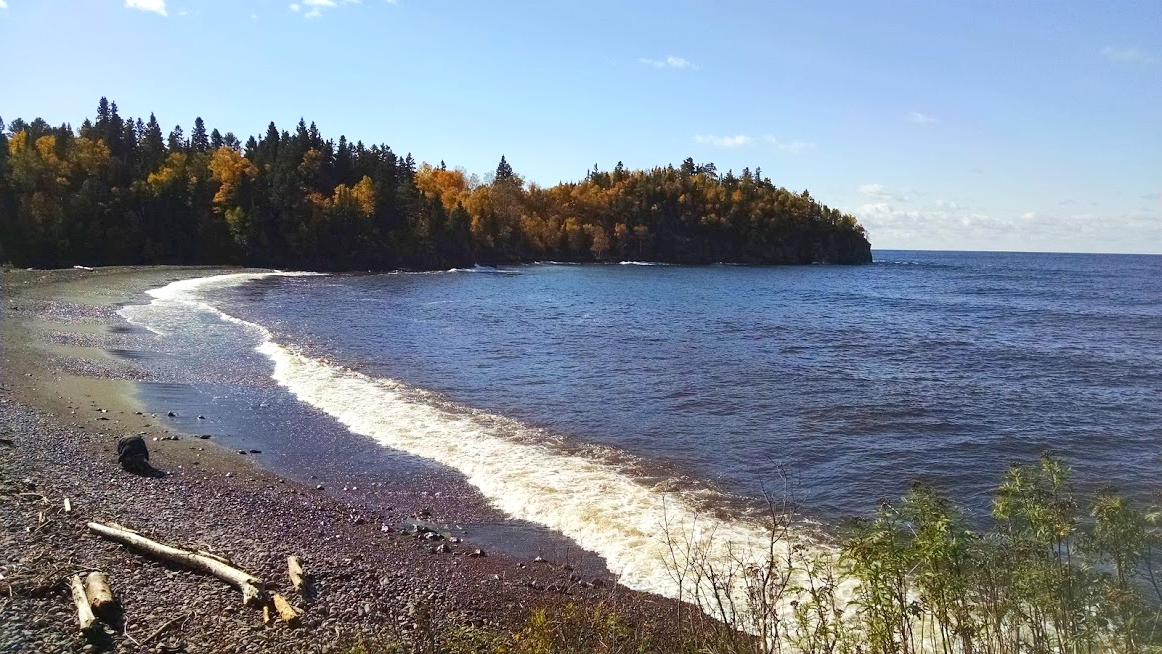
Even when the target rock is not found, the places where you search are often a treat in themselves.
Care To Join?
The software and the data referenced in this article are freely available and can be installed on practically any device. If you want to follow along and try doing this yourself, download the incredible open-source program QGIS HERE. A fresh new version (3.0) was recently released, so now is a great time to learn the wonders of GIS! Personally, I am still using an older version of QGIS (2.6) to maintain compatibility with some plugins that I require.

Source under CC-BY-SA - The latest version of QGIS is powerful, intuitive, and elegant!
Digging Up Data
There is a wealth of geologic spatial data to consider that might help with finding agates. An initial thought was to look at bedrock geology and identify the distribution of the basalt flows where the agates originate. This will work in areas where bedrock is exposed at the surface, but most of the bedrock in the Upper Midwest is buried by more than 100 feet of glacial material (See Figure 1 in the Deposit Thickness section below). In addition, the bedrock would still need to be mined to expose agates. For now we will focus on unconsolidated material that the glaciers churned up and left behind.
Surficial Geology
Geologic material that has yet to be consolidated into rock (lithified) is known as 'surficial' geology. It is sometimes referred to as 'Quaternary' geology in reference to the most recent period of geologic time. Multiple glaciations left material throughout upper North America during the Quaternary.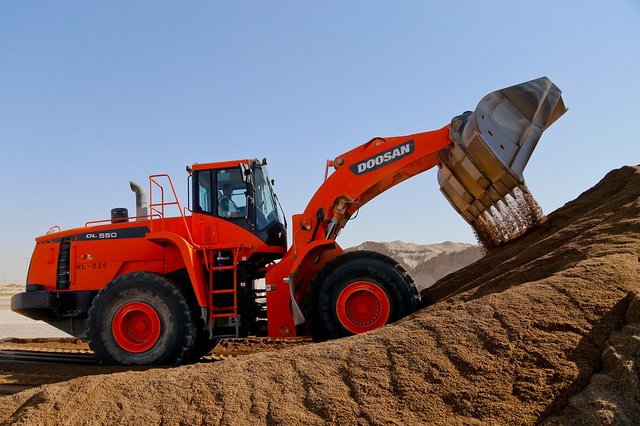
Source by sumanamul15 under CC0 - Continental glaciers act as a massive bulldozer, stirring up rock and grinding it into clay.
Unconsolidated material is generally differentiated by the grain size and sorting of the sediment, an attribute related to the depositional environment. We'll have to understand the geologic terms used to describe surficial geology in order to best prioritize the data for finding agates. These terms and names can vary greatly between data sets and authors, making the task of deciphering the meaning and correlating units a challenging geospatial puzzle...Settle in - this post will be fairly comprehensive!
National Scale
For the purposes of this article, I have chosen to work with data from a national level. The US Geological Survey published a map and data set of the surficial geology of the United States at a 1:5,000,000 scale in 2009. This data covers most of the potential range of Lake Superior Agates (omitting Canada).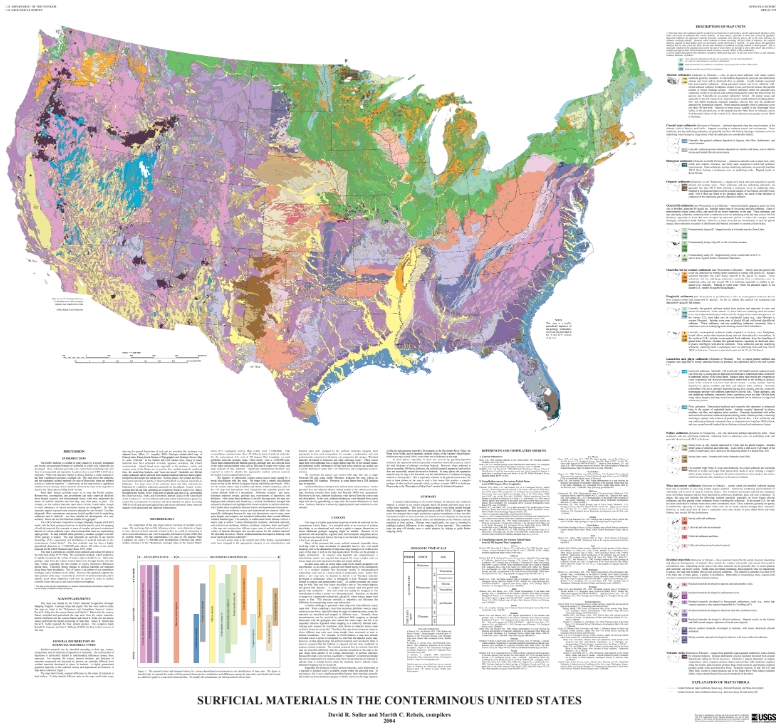
Source [a] - USGS Publication from 2009 showing the surficial geology of the mainland US.
While the map is useful for reference, a digitized version of the data allows for a more customized data analysis. The GIS data set can be downloaded as a Shapefile or as a Geodatabase. While the geodatabase is smaller in size, this format is a proprietary file type that can only be read by ArcGIS (by ESRI). Many University students have access to this software at no cost, but in this article we will use Shapefiles as they are easy to work with in either software suite.
Loading Shapefiles
The US surficial Shapefile based on the above publication is 112 MB in size and can be downloaded HERE. Once downloaded, the zipped folder must be unpacked using native decompression software before it can be opened with QGIS. The unzipped folder contains 24 files, including three shapefiles (also known as vector files). To add the Shapefiles in QGIS, go to Layer -> Add Layer -> Add Vector Layer and click browse to change the source to the unzipped folder. Sort by type and find the three files with the file extension .shp - Contacts, State_Lines, and Surficial_materials. 'Contacts' is a line file tracing the surficial polygons that will not need to be loaded for this analysis. The other two layers, however, will both be useful to load. The 'State_lines' layer outlines state boundaries, and the 'Surficial_materials' layer contains polygons encompassing unconsolidated material.
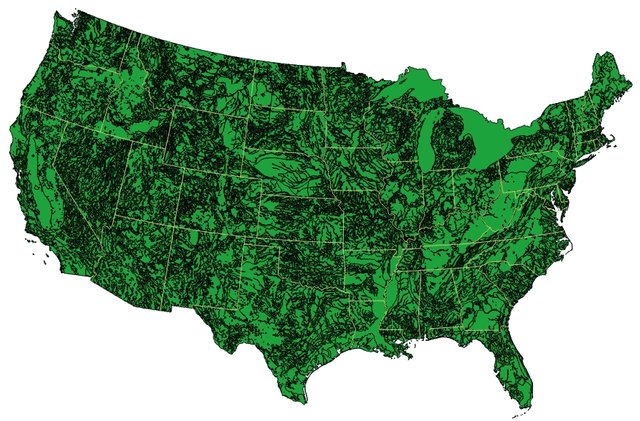
1:5,000,000 Surficial Geology Shapefile for the continental US. All features are colored the same by default upon initial load.
Unit Name
To differentiate the monochrome units and get a view that is similar to the USGS published map, we need to adjust the style of the layer. Right-click the 'Surficial_materials' layer in the Layers Menu and select Properties to bring up the style options. Toggle the first option from Single Symbol to Categorized and selectUNIT_NAME as the Column. Now we simply Classify the data to assign random colors to each unit. Here is the result: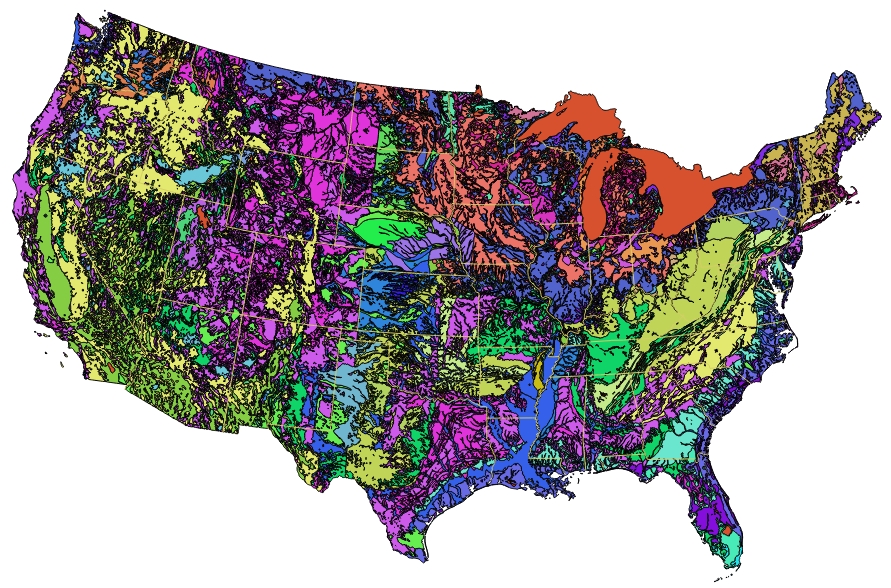
1:5,000,000 Surficial Geology Shapefile for the continental US. Features are categorized by Unit Name and are colored randomly.
You might notice that the colors are a little different than the USGS map, as the styles are not matched. This type of visualization helps with contemplating the complexity of surficial deposit distribution, but the random colors are not very useful for identifying where to look for agates. Before we make those colors more meaningful, there are a couple other useful columns to consider.
Deposit Thickness
As alluded to earlier, knowing the location of the bedrock geology that Lake Superior Agates are formed in is not entirely helpful in locating the agates. Bedrock is generally obscured by thick deposits of till and glacial outwash in Minnesota, Wisconsin, and Michigan where the Keeweenawan Rift Valley formed. Glacial erosion on this bedrock during the most recent glaciations exposed and transported agates beyond the extent of their source rock. The thickness of surficial deposits can be visualized by styling with the UNIT_THICK column.
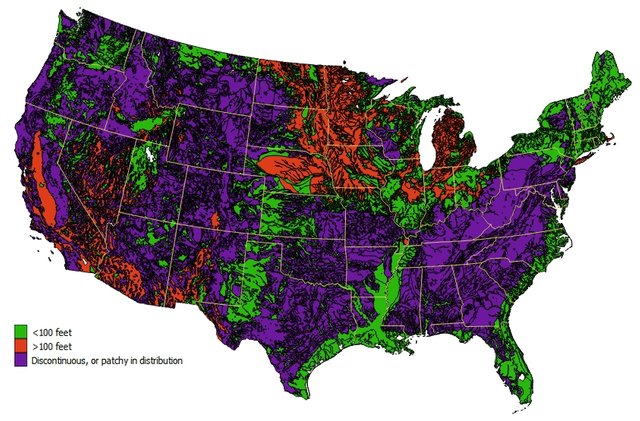
Figure 1: 1:5,000,000 Surficial Geology data set showing the thickness of surface material / depth to bedrock with color legend.
Deposit Age
Another column that might be useful to style the data with is that of UNIT_AGE. Because this data represents a generalized map of the entire country, the time ranges that deposits are lumped into are somewhat broad. Despite this, when the map is styled by 'age' the results are quite interesting:
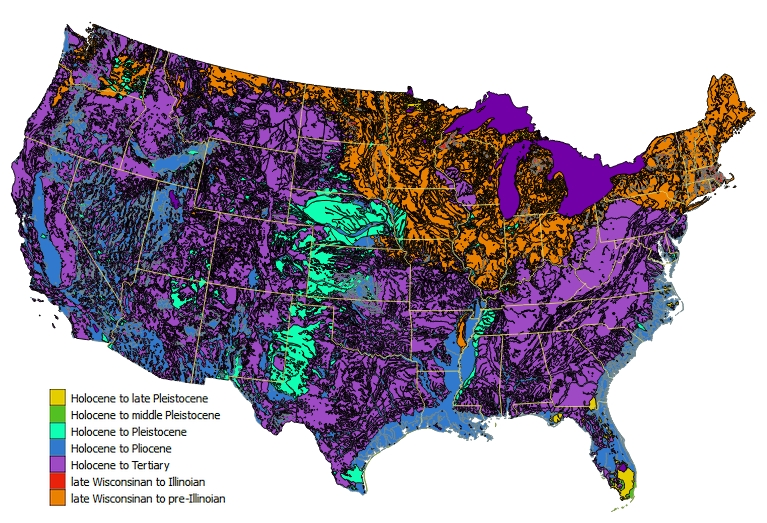
1:5,000,000 Surficial geology map styled by 'UNIT_AGE' with legend. All units represent time ranges, and the oldest deposits are cooler colors.
At first glance, it is clear that the most recent deposits (orange and red) tend to be in the northern part of the country. This corresponds with the Wisconsin and Illinoian stages of glaciation. These are the two most recent glacial events, both occurring within the Holocene. Since we know that the majority of Lake Superior Agates are found in glacial material, we can use the distribution of the orange and red units in the above figure as a rough guide for where to focus our attention.
Focusing In
Before proceeding with an analysis of this data in terms of the propensity to possess Lake Superior Agates, it is worthwhile to clip the data set to an area of interest and reduce the overall file size. Though the absolute range of the gemstones is not entirely clear, we can assume that finding the agates is highly unlikely beyond a certain distance from the source rock. As discussed in the previous article, the states of Michigan, Wisconsin, and Minnesota all have the right bedrock to produce agates. If we couple this knowledge with the progression of glaciers during the Holocene, a general search area can be approximated.
Select and Save
The easiest way to filter the data set into an area of interest is to select the desired units with the Select Tool on the Attributes toolbar. This should be turned on by default, but can also be activated through View -> Toolbars -> Attributes. Using this tool we can simply drag a rectangle over Minnesota, Wisconsin, Michigan, and Iowa, as well as parts of Missouri, Illinois, Indiana, and Ohio. The southern limit of Wisconsin and Illinoian deposits serves as a rough southern boundary for the rectangle.
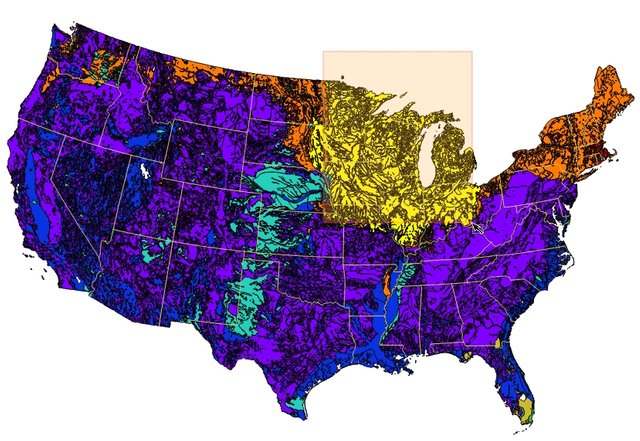 Using the Select Tool to create a rough rectangle that highlights the geographic areas most likely to have Lake Superior Agates
Using the Select Tool to create a rough rectangle that highlights the geographic areas most likely to have Lake Superior Agates
Now that the units of interest are selected, right-click on the 'Surficial_materials' layer and select Save As. In the context menu, select ESRI Shapefile as the file type, give the file a name, and make sure to check Save only selected features. The resultant file, colored randomly by UNIT_NAME, should look something like this:

Examining Attributes
Once the data set is whittled down spatially, it becomes much easier to work with. We can begin to consider the individual units and determine how likely each is to contain agates. To see what units remain in our geographic selection, simply expand the layer in the Layers Panel. This acts as a makeshift legend for the map and lists the different classifications of the units being differentiated.
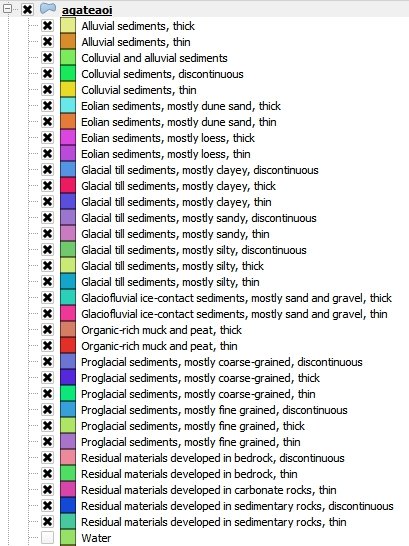
Most units are differentiated in multiple ways - first by deposit type, then by sediment size and deposit thickness. The thickness is not critical in terms of finding agates, but the sediment size is quite useful. In general, silts (Eolian deposits) and the fine sands of proglacial outwash are unlikely to contain gravel-sized agates. Likewise, soil derived from bedrock (residual materials, colluvium) will only contain agates if the local bedrock contains them. Clay-rich deposits like lacustrine, organic muck, and many glacial tills are not the most ideal place to find gravel, but the high energy environment of a glacier can move sediment of all sizes. The best place to look for gravels is in coarse-grained sediment such as alluvial deposits, glaciofluvial outwash, and certain tills that are near the source bedrock. By simply turning off the undesirable units in the Layer Panel, we can start to generate a refined agate map.
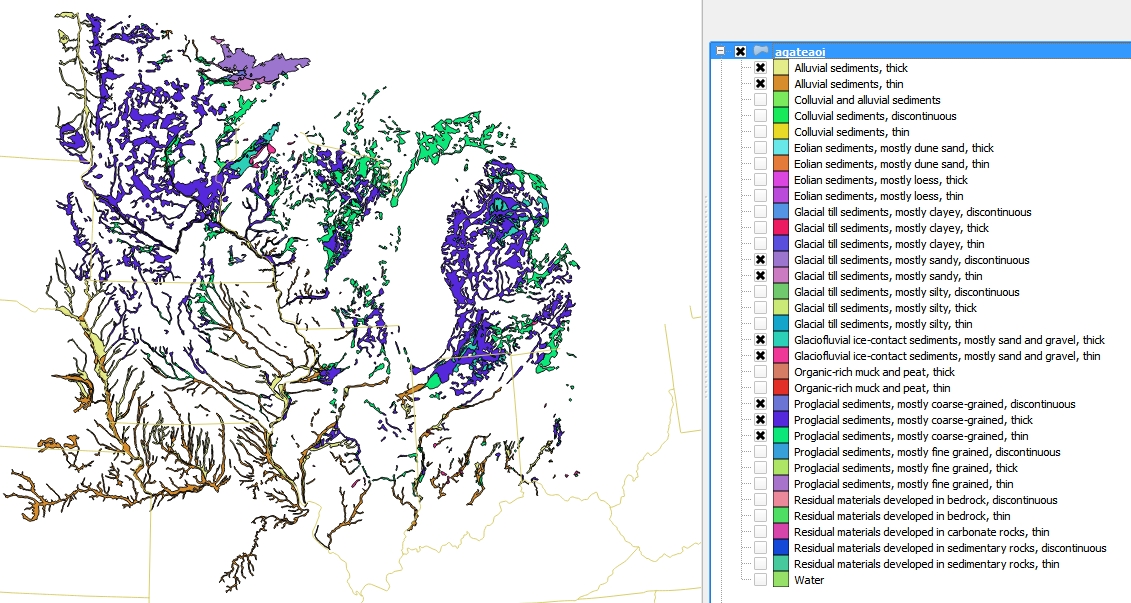
Finishing Touches
A final step in optimizing this data is to apply a meaningful color scheme to the polygons. I opted to manually color the remaining units based on the grain size of the deposits and energy of the depositional environments, but a color ramp could also be created or applied as an alternate solution.
Areas with the coarsest sediment and therefore highest probability of finding gravels are highlighted in reds and oranges, while the cooler colors are less ideal. Keep in mind that we have already eliminated the least probable units from the data set, so even cooler colored units have a good chance of containing agates.

The above figure is my best attempt at creating a Lake Superior Agate hunting map using the 1:5,000,000 data. As discussed in the first article in this series, the glacial history that exposed Lake Superior Agates is complex. Unfortunately, this data has no indication of the glacial lobe associated with deposits beyond glacial stages, so we must rely on a spatial estimate. The last article established that the most probable locations to find Lake Superior Agates are in Superior Lobe deposits, which tend to be found in near the Lake Superior basin in Eastern Minnesota, Northern Michigan, and Wisconsin.
 Magnified color-coded map showing the areas and deposits most likely to contain Lake Superior Agates based on the 1:5,000,000 data. Basemap by OSM
Magnified color-coded map showing the areas and deposits most likely to contain Lake Superior Agates based on the 1:5,000,000 data. Basemap by OSM
Improvements
The above graphics provide a first-attempt at locating the most probable locations to look for Lake Superior Agates. There are some obvious setbacks to this data, including the coarse scale and broadly lumped attributes. Nevertheless, I can verify that the map has correctly highlighted some locations in Minnesota that are known to produce agates. While this data can provide some useful insights, these limitations leave some definite room for improvement. The best way to create a better map is to locate better data. Each state has varying degrees of funding and personnel dedicated to mapping surficial deposits, but they all have state-level data available at a better scale than the data set utilized in this article.
Minnesota even has detailed aggregate maps at the county level up to a scale of 1:24,000! Once this data is massaged and processed in the right way, it has the capacity to precisely identify where to find agates - down to the scale of individual gravel pits and creeks. Truth be told, this detailed analysis on high-resolution data has already been performed and distilled into a powerful map-based tool that can be accessed from any device. If you are interested in rockhounding and want to use the best information available to gain an edge on the competition, contact me on discord! Happy hounding!
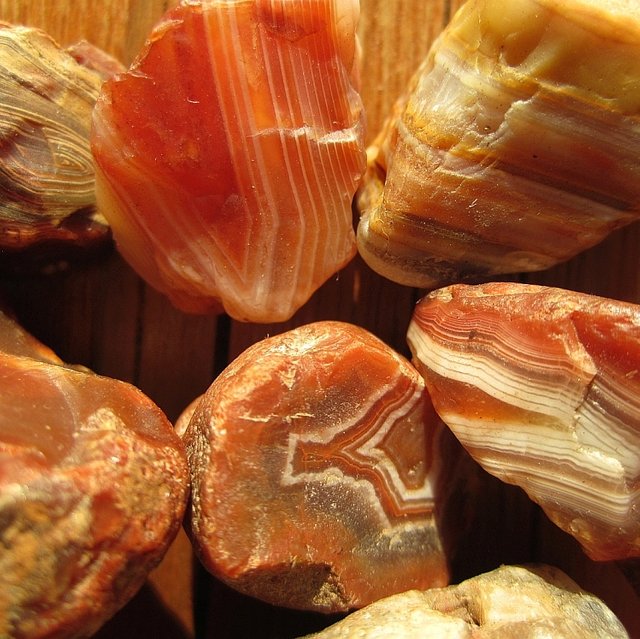
A small sampling of agates discovered through GIS.
External References
- [a] - Soller, D.R., Reheis, M.C., Garrity, C.P., and Van Sistine, D.R., 2009, Map database for surficial materials in the conterminous United States: U.S. Geological Survey Data Series 425, scale 1:5,000,000 [https://pubs.usgs.gov/ds/425/].
- Huber, N K. The Keweenawan geology of Isle Royale, Michigan. US Geological Survey, 1971. [https://pubs.er.usgs.gov/publication/ofr71154]
- Huber, N K. The Geologic Story of Isle Royale National Park. US Geological Survey, 1975. [https://pubs.er.usgs.gov/publication/b1309]
- QGIS Development Team (2018). QGIS Geographic Information System. Open Source Geospatial Foundation Project. http://qgis.osgeo.org".
- Basemaps in the final two graphics: © OpenStreetMap Contributors, under CC-BY-SA 2.0
Sweet Mother Catalyst. Comprehensive is an understatement. Awesome post, learned a ton. Reposting and promoting.
Downvoting a post can decrease pending rewards and make it less visible. Common reasons:
Submit
I am glad you enjoyed it...I know that the post is a little long but there was a lot I wanted to cover. Thanks for the repost!
Downvoting a post can decrease pending rewards and make it less visible. Common reasons:
Submit
This is one of the frustrating things about Steemit, more people need to see and would appreciate this post, but in a couple of days it will go into nowhere nowhere land. @roadscape is there a solution to this coming?
Downvoting a post can decrease pending rewards and make it less visible. Common reasons:
Submit
The solution is post a small addition once a week with links to full material.
Not ideal but works.
Steem is for short materials with a little lifespan.
Downvoting a post can decrease pending rewards and make it less visible. Common reasons:
Submit
mee too
thanks @gra
Downvoting a post can decrease pending rewards and make it less visible. Common reasons:
Submit
You received a 60.0% upvote since you are a member of geopolis and wrote in the category of "geology".
To read more about us and what we do, click here.
https://steemit.com/geopolis/@geopolis/geopolis-the-community-for-global-sciences-update-4
Downvoting a post can decrease pending rewards and make it less visible. Common reasons:
Submit
It's fascinating how you are able to use this data to yield tangible results in the quest to find particular rocks. You truly piece together an interesting presentation, on a subject that by rights I should have no interest in at all. Yet here I sit, reading about and fascinated by lake superior agates. I applaud you on another fantastic post.
Downvoting a post can decrease pending rewards and make it less visible. Common reasons:
Submit
Cheers that the article was able to maintain your interest! Perhaps there is an inner rockhound in everyone? I appreciate the support and encouragement. Thanks for reading!
Downvoting a post can decrease pending rewards and make it less visible. Common reasons:
Submit
Its crazy to think that we already know so much about the geological makeup of the US that we can use this information to pinpoint very precise probable locations of a specific rock. Awesome post.
Downvoting a post can decrease pending rewards and make it less visible. Common reasons:
Submit
Thank you! You are absolutely right, this sort of analysis is only possible due to the vast amount of free geologic data that already exists. As state and federal agencies continue to refine and improve the resolution of this data, the future looks very bright for rockhounds!
Downvoting a post can decrease pending rewards and make it less visible. Common reasons:
Submit
As a fellow #rockhound I have to say you nailed this one. Amazing work! I've spent some time researching where would be the best place to hunt for agates at and around Lake Superior and never got this much info out of it. Of course, being where I am it's not difficult to find them at all but this could definitely help!
Downvoting a post can decrease pending rewards and make it less visible. Common reasons:
Submit
Thank you! Glad to see some other rockhounds on here! You do seem situated in an ideal location to hunt for agates.
Wisconsin has some slightly better data than I presented in this article, but the Minnesota data has incredible resolution! There is also a database of over 6,000 gravel pits, some long abandoned. Have you found certain beaches to be more productive / less picked than others?
Downvoting a post can decrease pending rewards and make it less visible. Common reasons:
Submit
Yes the mouth of the Amnicon River and Lake Shore Point are two of the most visited when it comes to my immediate area but there are so many agates. When I go it's usually towards the end of the day and I can see other rockhounds leaving as I get there and I still find a bunch of them. Along the railroad tracks, alog gravel and dirt roads I always find many too. It really is a prime location and I found that after researching where to go the answer is just go anywhere.
I've been trying to populate the #rockhound tag lately and created an account @rockhounds to help with curation of said tag. With other tags like #rocks there are a lot of articles that don't exactly pertain to rockhounding since someone can tag #steemit #rocks. #rockhound is a place for true rockhounds to share their finds. If you share more #rockhound material I'd love it if you helped me populate the tag!
Downvoting a post can decrease pending rewards and make it less visible. Common reasons:
Submit
Thanks for the tips! The next time I am up along the North Shore I will check out those locations. They really do have a wide range, and you're right in the heart of it!
I support using the #rockhound tag and will surely make some future contributions. Here is a previous post I made on finding Keokuk Geodes that would qualify!
Downvoting a post can decrease pending rewards and make it less visible. Common reasons:
Submit
You are quite the talented writer. The level of detail in your articles and the data you compile is amazing. It covers a lot of information that I've been trying to find online all in one neat article. I will have to bookmark both of these, my rockhounding friend @honeybadger-1 would love to read this.
Downvoting a post can decrease pending rewards and make it less visible. Common reasons:
Submit
That is a very kind offer that I'll be sure to take you up on some time. Thanks for the praise and for sharing my post with your rockhounding friends!
Downvoting a post can decrease pending rewards and make it less visible. Common reasons:
Submit
GIS is such an incredibly powerful tool. I wish I would have put more effort into learning how to use it. I also never knew that an open source version exited. Do you know the drawbacks of it compared to ArcGIS?
Downvoting a post can decrease pending rewards and make it less visible. Common reasons:
Submit
Thank you for your comment! It is definitely not too late to learn how to use GIS. There are a couple of differences between QGIS and ArcGIS that might be considered drawbacks by some. For one, ArcGIS generally has a larger suite of tools and scripts to choose from. To get the same functionality with QGIS on certain tasks like slope and hydrological analyses, you either have to install third-party plugins or use a complimentary program called Grass GIS.
QGIS also behaves and looks a little different stylistically, so if you are already familiar with Arc then it might take some relearning. One of the biggest drawbacks is that certain files such as Geodatabases are proprietary file types that can only be opened by ArcGIS. Unfortunately, some state and federal organizations provide their data exclusively in this format, making it necessary to first convert the file if you want to use it in QGIS.
Downvoting a post can decrease pending rewards and make it less visible. Common reasons:
Submit
@gra Whoa!!!
That was an incredible Geology blog! I'm a Rural & Surveying Engineer and Geology is one of the various scientific fields I've studied! I can't believe I only just found your blog! I was thinking about blogging about Geology in the future as well and then I saw this post of yours!
Very well articulated, simplified article. Thank you so much! I've been using usgs.gov in University, and QGIS is my favourite GIS software without a doubt, mainly due to the fact that it is open source. Didn't know about QGIS 3.0 though, looks pretty cool! I'm still using QGIS 2.8.1 Wien.
Anyway, thanks for your wonderful work, I'm now tuned!
Keep it up!
Downvoting a post can decrease pending rewards and make it less visible. Common reasons:
Submit
I look forward to seeing some future Geology posts from you! I am always happy to find other GIS enthusiasts on here, especially ones that appreciate the open source option. Pretty much any version of QGIS after 2.0 is great for everyday use, but the latest version has a lot of new features. Thanks for checking it out my blog and sharing your experiences, glad to have you on board!
Downvoting a post can decrease pending rewards and make it less visible. Common reasons:
Submit
Thanks for the encouragement! It was a pleasure reading your work. Catch you around!
Downvoting a post can decrease pending rewards and make it less visible. Common reasons:
Submit
What an interesting article u wrote..!! 🙌
I've heard the name "GIS" from my frnds in URP department, they seem to use this tool a lot. But never knew that it can search things this much specific way..!!!
And u explained the usage of it in an interesting way..!
Didnt think that studying rocks can be this much cool..!! The seashore seems to have a lot of colors in it..!
A great article, mentor..!!! 👏👍
~ Christina
Downvoting a post can decrease pending rewards and make it less visible. Common reasons:
Submit
The shoreline featured in the post definitely has a wide variety of colors and rock types. Without doubt, it is one of my favorite beaches!
Stay tuned for future articles where I start to unveil the real power of GIS...this is just an introduction! Thanks for your comment 👍
Downvoting a post can decrease pending rewards and make it less visible. Common reasons:
Submit
definitely waiting for ur future post..!!!! 🙌
best reagrds to u..!!!!
Downvoting a post can decrease pending rewards and make it less visible. Common reasons:
Submit
BRB, figuring out where the emeralds are in the great smoky mountains.
Downvoting a post can decrease pending rewards and make it less visible. Common reasons:
Submit
That is actually a pretty good idea, I might have to do a future post on this if you don't beat me to it!
Downvoting a post can decrease pending rewards and make it less visible. Common reasons:
Submit
You go ahead and write it, I'll be too busy making a throne encrusted in jewels.
Downvoting a post can decrease pending rewards and make it less visible. Common reasons:
Submit
Hmmm, I like shiny black rocks more than any other rock/stone. Not a fan of agates but tumbled agates look ok too. :)
Oh the terms... so which color in the images mean it's where the best agates are again? I think this is a very useful post for gem collectors.
Downvoting a post can decrease pending rewards and make it less visible. Common reasons:
Submit
Thanks for the comment. Shiny rocks are nice, but colors are so pretty! Agates may be a little ugly before tumbling, but they sure do clean up nicely!
In general, the warmer colors (reds, oranges, yellows) represent the best spots to find agates, while the cooler colors (greens, blues, purples) are less desirable spots. However, in the last two figures of the post, I have already filtered out the less likely locations so any colored unit is a decent location to try looking. I hope people find this useful, it is my goal to make rockhounding more enjoyable for everyone!
Downvoting a post can decrease pending rewards and make it less visible. Common reasons:
Submit
I just watched The Secret Rules of Modern Living: Algorithms, a doc about the many areas of our lives that are aided or ruled by algorithms, and here you are explaining how a software can help us find better places for rock prospecting!
Very professional article btw! 👍
Downvoting a post can decrease pending rewards and make it less visible. Common reasons:
Submit
Thanks! I'll have to check that out. GIS software has incredibly immense capabilities...I fully believe in the power of algorithms to do good!
Downvoting a post can decrease pending rewards and make it less visible. Common reasons:
Submit
Can it help us find gold? That's what I want to know :P
Downvoting a post can decrease pending rewards and make it less visible. Common reasons:
Submit
A post on hunting for gold would be very interesting. I'm pretty sure it can happen...thanks for the idea!
Downvoting a post can decrease pending rewards and make it less visible. Common reasons:
Submit
Haha, @gra, this is the first post of yours am reading and you left a indelible mark here in me.Using data collection software to identify site of agates.This is a mouth watering post.Those stones inside actually look like a red meat.
Downvoting a post can decrease pending rewards and make it less visible. Common reasons:
Submit
One will be stupid enough to start eating stones .😁
Downvoting a post can decrease pending rewards and make it less visible. Common reasons:
Submit
Thanks! I would advise against try to eat agates, despite how protein-rich they may appear...
Downvoting a post can decrease pending rewards and make it less visible. Common reasons:
Submit
WARNING - The message you received from @joyarif is a CONFIRMED SCAM!
DO NOT FOLLOW any instruction and DO NOT CLICK on any link in the comment!
For more information, read this post: https://steemit.com/steemit/@arcange/phishing-site-reported-postupper-dot-ml
Please consider to upvote this warning or to vote for my witness if you find my work to protect you and the platform valuable. Your support is really appreciated!
Downvoting a post can decrease pending rewards and make it less visible. Common reasons:
Submit
I appreciate the warning!
Downvoting a post can decrease pending rewards and make it less visible. Common reasons:
Submit
@gra ,this is your first post I read,and you left an indelible mark here in my mind. Those precious agates stones actually look like red meat inside.Using data for the location of agates Stone is mouth watering.
Downvoting a post can decrease pending rewards and make it less visible. Common reasons:
Submit
I only just recently came across this article, and its very interesting. As a rockhound im very interested in the resource you mentioned at the end. It seems you may no longer be active here, but I dont see any way to contact you through discord, so I hope you see this. Anyway, thankyou for your dedicated research.
Downvoting a post can decrease pending rewards and make it less visible. Common reasons:
Submit
Congratulations @gra! You have completed some achievement on Steemit and have been rewarded with new badge(s) :
Click on any badge to view your own Board of Honor on SteemitBoard.
To support your work, I also upvoted your post!
For more information about SteemitBoard, click here
If you no longer want to receive notifications, reply to this comment with the word
STOPDownvoting a post can decrease pending rewards and make it less visible. Common reasons:
Submit
Downvoting a post can decrease pending rewards and make it less visible. Common reasons:
Submit
Spam is discouraged by the community, including comment spam.
Tips to avoid being flagged
Thank You!
Downvoting a post can decrease pending rewards and make it less visible. Common reasons:
Submit